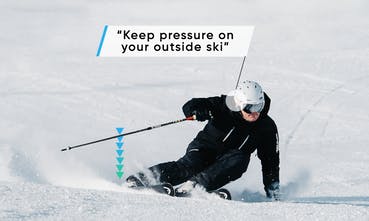DECEMBER 12, 2020 – Recently I re-instituted a daily discipline: practicing my violin. This consists of scales and arpeggios, a movement of a Bach partita, then 20 minutes of new repertoire work—currently, Dvorak’s Romance.
Who knows—maybe the pandemic will end and my piano collaborator and I can work up the Dvorak to house concert quality. With distribution of a little wine to reduce standards among our audience members, we might even attract . . . an audience. Whether all of that will transpire is speculative. What’s not speculative is that without the daily discipline the future house concert is guaranteed not to happen.
For me this daily discipline is fun and rewarding.
Some people know that I “ski” when I play the violin. That’s right. I pretend my bow and fiddle are my skis and poles—and that I’m on a college Alpine ski team. My imaginary coach is an old geezer—about my current age—but in his day, I’m told, he was quite the competitor . . . at least in his imagination. I once saw a photo of him as he rounded a slalom gate. What impressed me was the determination on his face and . . . the size of the baskets on his ski poles. To be competitive back then, you first had to overcome the primitive gear.
Anyway, Old Man coach is a nice enough guy but out on the mountain, he’s all business. At the core of his instructional technique is an unrelenting question: “Were you happy with that?” You don’t ever dare say, “Yes,” because he’ll say, “When you’re happy, I’m not happy.” But you can’t simply say, “No, I’m not happy with that.” He’ll ask why you weren’t happy with your run. And he’s not looking for, “My timing was bad on gates five and six” or “my form was off on the first three gates.” No sirree. You have to explain why your timing was off or what exactly was sub-standard about your form.
I think the coach’s technique works. He knows that learning runs deeper if you’re forced to analyze, experiment, and figure out stuff on your own. His job is to make sure you’re focused and thinking—thinking—constantly about what you’re doing out there on the mountain.
The Old Man’s toughness can be a pain in the butt sometimes, but I know his attitude reflects how much he loves the sport and how much he wants me to enjoy it too. “It’s not enough to be the fastest skier down the course,” he’ll say. “You’ve got to be the best looking skier too.” Once he elaborated on this. “Speed is simply gravity minus friction,” he said. “But the art of skiing? That’s an expression of beauty that transcends the laws of physics.”
I try hard to keep that in mind every time I go down the course. At the same time I focus on speed and making the tightest possible turns, I also think, “How do I become one with the beauty of this magnificent mountain?”
(Remember to subscribe to this blog and receive notifications of new posts by email.)
© 2020 by Eric Nilsson
